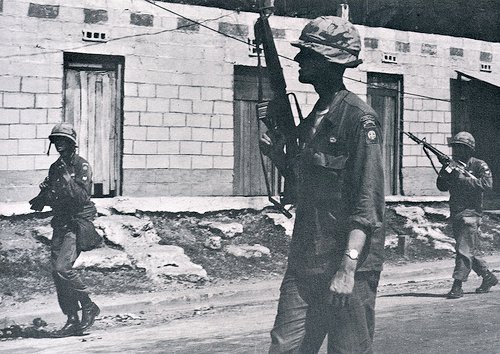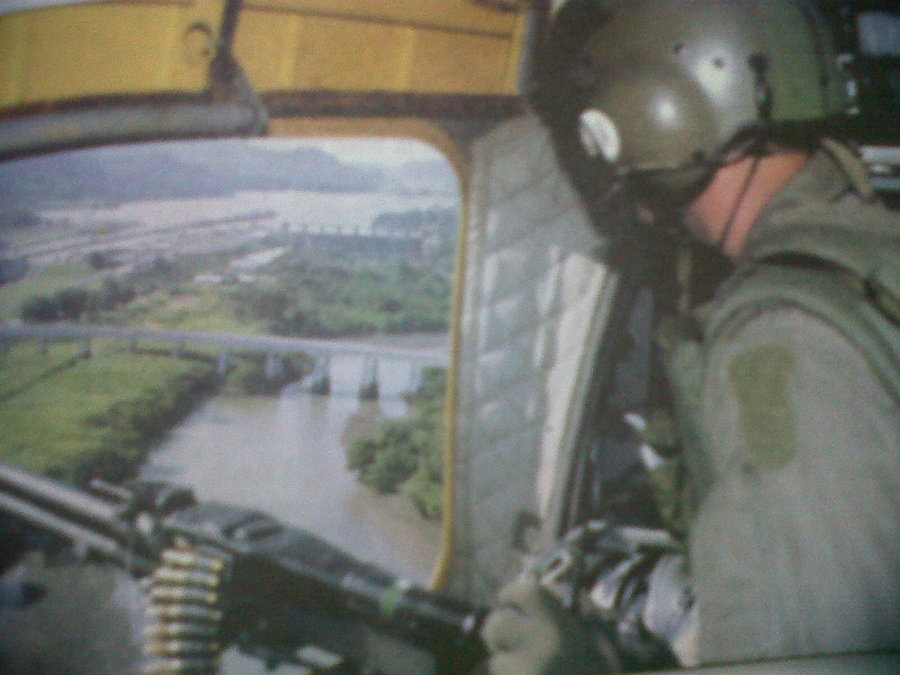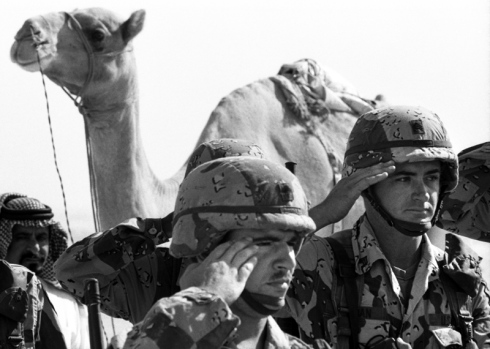XVIII Airborne Corps History

XVIII Airborne Corps, with Headquarters at Fort Bragg, was originally activated as the II Armored Corps at Camp Polk, La., Jan. 17, 1942. It was redesignated XVIII Corps Oct. 9, 1943, at the Presidio of Monterey, Calif.
The Corps celebrates its birthday on Aug. 25, 1944, when the blue airborne tab was added at Ogbourne, St. George, England. On this same day, the XVIII Airborne Corps assumed command of the 82d and 101st Airborne Divisions and Major General Matthew B. Ridgway became the first Corps Commander. Within a month of reaching Europe, General Ridgway was in the air over the Netherlands as two of the Corps' combat elements, the 82d and 101st Airborne divisions participated in WWII's largest combat jump—Operation Market Garden. The Corps headquarters soon joined them on the ground for prolonged fighting alongside British tankers, infantrymen and paratroopers.
England. On this same day, the XVIII Airborne Corps assumed command of the 82d and 101st Airborne Divisions and Major General Matthew B. Ridgway became the first Corps Commander. Within a month of reaching Europe, General Ridgway was in the air over the Netherlands as two of the Corps' combat elements, the 82d and 101st Airborne divisions participated in WWII's largest combat jump—Operation Market Garden. The Corps headquarters soon joined them on the ground for prolonged fighting alongside British tankers, infantrymen and paratroopers.
Early winter found the Corps split between bases in France and England preparing for other potential airborne operations. When Hitler unleashed the Ardennes Offensive, these forces constituted the only mobile reserves that the Allies had. Within a matter of hours the Corps was on its way to the Ardennes. The 101st held on to Bastogne's critical road junction, while the rest of the Corps, reinforced by armor and infantry divisions, stopped the penetration and then helped to push the exhausted Germans back to their original positions, during the "Battle of the Bulge."
For the rest of the war, XVIII Airborne Corps showed its versatility by concentrating on ground operations. It played a major role in the reduction of the Ruhr "pocket," shifted at lightning speed to launch the last airborne operation in the theater-Operation Varsity to cross the Rhine alongside the British and then dashed north and east to the Elbe and the Baltic coast of Germany.
The XVIII Airborne Corps then moved back to the United States in late June 1945, to prepare for the invasion of the Japanese home islands. Before that deployment could take place, however, the war ended. On Oct. 15, 1945, at Camp (now Fort) Campbell, Ky. XVIII Airborne Corps was inactivated. With the global force build-up caused by the Korean War, the nation once again called on XVIII Airborne Corps. XVIII Airborne Corps was reactivated on May 21, 1951, at Fort Bragg, N.C., "Home of the Airborne," replacing V Corps, which deployed to Europe. Thousands of inductees and members of the National Guard and Army Reserve were called to active duty and were trained at Fort Bragg, for service during the Korean War. In October 1951, the 11th Airborne Division was attached to the XVIII Airborne Corps.
The outbreak of civil disturbances in the United States became an area of activity for the XVIII Airborne Corps. In the fall of 1957, a federal order to integrate the public schools in Little Rock, Arkansas precipitated public disorders, and United States Marshals were unable to maintain control. President Eisenhower, when compelled to summon government troops, selected a XVIII Airborne Corps unit to do the job—the 101st Airborne Division. With discipline, tact and efficiency, the mission was accomplished. In 1961, the construction of the Berlin Wall and the presence of the Soviet Army in the city, led to the Corps being placed on alert. The stand-off ended, in the summer of 1962, when the East German government backed down.
United States Marshals were unable to maintain control. President Eisenhower, when compelled to summon government troops, selected a XVIII Airborne Corps unit to do the job—the 101st Airborne Division. With discipline, tact and efficiency, the mission was accomplished. In 1961, the construction of the Berlin Wall and the presence of the Soviet Army in the city, led to the Corps being placed on alert. The stand-off ended, in the summer of 1962, when the East German government backed down.
On Jan. 1, 1962, the U.S. Army reorganized the XVIII Airborne Corps under STRAC. STRAC was composed of two Corps, XVIII Airborne Corps and III Corps. These units were especially tailored to fight a limited war anywhere in the world. Attached to XVIII Airborne Corps were the 82d and 101st Airborne Divisions, the 1st and 4th Infantry Divisions, as well as numerous combat and logistical support units. STRAC troopers were Skilled, Tough and Ready Around the Clock.
In September 1962, violence broke out in Oxford, Mississippi, when U.S. Marshals attempted to carry out a federal court order to admit an African-American, James H. Meredith, to the University of Mississippi. Soldiers of the XVIII Airborne Corps were summoned and the riots were rapidly quelled by the troops, who showed restraint, tact and self-control.
 In October 1962, units of XVIII Airborne Corps were placed on alert for potential commitment, during the Cuban Missile Crisis. Nuclear war was overted after the intercession of the United Nations and Corps troops stood down. From April 30, 1965, to Jan. 17, 1966, the XVIII Airborne Corps served in the Dominican Republic, during Operation Power Pack, as Headquarters, U.S. Forces Dominican Republic. Corps Soldiers were sent to restore law and order, prevent a communist takeover of the country and protect American lives.
In October 1962, units of XVIII Airborne Corps were placed on alert for potential commitment, during the Cuban Missile Crisis. Nuclear war was overted after the intercession of the United Nations and Corps troops stood down. From April 30, 1965, to Jan. 17, 1966, the XVIII Airborne Corps served in the Dominican Republic, during Operation Power Pack, as Headquarters, U.S. Forces Dominican Republic. Corps Soldiers were sent to restore law and order, prevent a communist takeover of the country and protect American lives.
Almost immediately after returning to Fort Bragg, attention shifted to the need to prepare units for duty in Southeast Asia. Over 200 elements trained up under XVIII Airborne Corps' guidance and shipped to Vietnam, including the entire 101st Airborne Division and the 3rd Brigade of the 82d Airborne Division. During the Vietnam  era, more than 200,000 trainees underwent basic training at Fort Bragg, the majority from 1966 to 1970. At the peak of the war, in 1968, the military population at the installation was nearly 58,000.
era, more than 200,000 trainees underwent basic training at Fort Bragg, the majority from 1966 to 1970. At the peak of the war, in 1968, the military population at the installation was nearly 58,000.
In 1967, XVIII Airborne Corps troops also saw action in Detroit and in the Congo. Paratroopers from the 82d and 101st were sent to Detroit, Michigan, to suppress riots there and in the Congo, for Operation Dragon Rouge, XVIII Airborne Corps forces gave support to the established central government and rescued civilians being held hostage.
In July 1973, XVIII Airborne Corps was assigned under U.S Army Forces Command (FORSCOM). The capability for rapid deployment into an environment where normal points of entry, such as ports or airfields, are not available, are a special skill that has been the training and planning focus of XVIII Airborne Corps throughout most of its sixty-five years of existence. In peacetime, the quick reaction ability was tested constantly through the use of no notice Emergency Deployment Readiness Exercises (EDREs) and was the foundation of the Corps' program to sustain its high standards.
Beginning in 1982, the XVIII Airborne Corps routinely furnished contingents for rotations in the Sinai Peninsula as part of the Multinational Force and Observers to help guarantee the Camp David Peace Accords. The Corps regularly participated in exercises such as Gallant Eagle and Bright Star, to test its abilities to respond to crises in the Middle East, Persian Gulf and Indian Ocean areas.
The XVIII Airborne Corps is superbly trained in tactical operational and strategic levels of war and is capable of exercising the nation's ability to conduct strategic forced entry operations, anywhere in the world on short notice. They have been widely recognized as a superbly trained force capable of operating from peace operations to general-purpose war and capable of conducting large-scale joint and combined operations.
|

Operation Urgent Fury Grenada, Oct. 25, 1983
At the request of President Reagan, the Corps provided the bulk of land forces sent to rescue medical students and other stranded Americans, and participated with our Caribbean neighbors in an international peacekeeping effort. |
|

Operation Golden Pheasant Honduras, 1988
When the borders of Honduras were threatened, elements of two Corps divisions exercised a show of force to ensure sovereignty of Honduran territory would be respected. |
|

Operation Nimrod Dancer Panama, 1989
A security reinforcement from XVIII Airborne Corps was sent to protect American citizens, facilities and treaty rights following elections. |
|

Operation Hawkeye U.S. Virgin Islands, September 1989
Following Hurricane Hugo, the Corps was on the ground, in St. Croix, within 13 hours, with the first elements of a Joint Task Force, to restore law and order and to provide emergency relief and rebuilding efforts for the devastated island. |
|

Operation Just Cause Panama, Dec. 20, 1989
The XVIII Airborne Corps in operational command of Joint Task Force South struck 27 targets simultaneously and conducted two night parachute assaults to seize critical terrain and set the stage for a freely-elected government to be established in the country. |
|

Operation Desert Shield Saudi Arabia, Aug. 9, 1990
Rapidly deployed as the first ground force in theater to spearhead efforts to deter aggression and assist in the defense of friendly nations, the largest American military deployment since WWII. |
|
Operation Desert Storm Saudi Arabia, January 1991
XVIII Airborne Corps launched the first ground assault into Iraq with the 82d Airborne Division and the attached French 6th Light Armored Division, the largest air assault in history by the 101st Airborne Division (Air Assault), and an armored thrust by the 24th Infantry Division (Mechanized) and the 3d Armored Cavalry Regiment. In less than 100 hours, the Corps had effectively sealed off the occupying Iraqi Army and destroyed major elements of the elite Republican Guard. |
|
Operation GTMO Cuba, November 1991
The corps established a humanitarian support center at Guantanamo Bay Naval Base to receive, transport, detain, control and process Haitian migrants. The corps quickly began the massive task of building and supporting a humanitarian center for more than 12,000 Haitians. By early December the corps had deployed over 2,000 soldiers to the Guantanamo Naval Base. The operation officially ended in June 1993. |
|

Operation Hurricane Andrew Florida, Aug. 27, 1992
On Aug. 27, 1992 major units throughout the XVIII Airborne Corps began their deployment to Dade County, Florida, to assist in disaster relief operations in the aftermath of the storm. At peak strength the corps had 16,000 Soldiers deployed to South Fla. The mission of the Corps was to provide immediate emergency relief including food, water, shelter and medical aid. During subsequent phases the corps conducted debris removal operations, repaired schools, established relief supply distribution centers and assisted the local government in establishing sustained recovery operations. All disaster relief functions were eventually turned over to civilian contractors and dorps units returned to Fort Bragg by Oct. 21, 1992. |
|

Operation Restore Hope Somalia, Dec. 13, 1992
In support of Joint Task Force Somalia, Army forces secured an airfield and key installations, and provided security to ensure safe passage of food and humanitarian supplies throughout the country. |
|

Operation Uphold/ Maintain Democracy Haiti, September 1994
To ensure the Haitian Armed Forces compliance with Carter-Cedras accords, protect U.S. citizens, restore civil order, assist in the reorganization of Haitian Armed Forces and assist in the transition to and maintenance of a democratic government. |
|

Vigilant Warrior Kuwait, October 1994
Nearly four years after Desert Storm the 24th Infantry Division returned to Kuwait to deter further Iraqi aggression, when Iraqi forces moved south to the border. They withdrew shortly after the arrival of the division. |
|

Operation Enduring Freedom (OEF) Afghanistan, May 2002 to May 2003
In 2002, elements of the XVIII Airborne Corps headquarters deployed to Afghanistan and formed the Combined Joint Task Force 180 (Afghanistan). CJTF-180 (AFG) assumed responsibilities for the majority of the forces currently in support of operations in Afghanistan. In addition, it directed and synchronized operations to destroy or capture remaining Al Qaeda/Taliban, prevent the re-emergence of international terrorist activities within Afghanistan and support humanitarian operations in order to create a peaceful and stable environment within Afghanistan. The corps redeployed back to Fort Bragg in May 2003. |
|

Operation Iraqi Freedom (OIF) Iraq, February 2005 to February 2006
The XVIII Airborne Corps Headquarters deployed to Baghdad in January 2005, where it served as the Multi-National Corps-Iraq Headquarters responsible for commanding more than 145,000 service members and 29 Coalition partners. During the one-year rotation, the corps successfully trained and equipped more than 100,000 Iraqi Security Forces, helped restore the Iraqi border and turned over numerous Forward Operating Bases throughout the country to the Iraqi Government. In addition, the corps created a security environment that enabled the Iraqi government to successfully conduct its national referendum vote and national election with more than 12.2 million voters participating in this process. |
|

Operation Iraqi Freedom (OIF) Iraq, Feb. 14, 2008 to April 4, 2009
XVIII Airborne Corps once again deployed to Iraq and served as Multi-National Corps-Iraq. As the operational level command element, the corps commanded a 26-nation coalition of more than 158,000 personnel, representing seven multi-national divisions. MNC-I partnered with the Iraqi Security Forces (ISF) to combat internal threats throughout the country which led to a significant drop in the number of attacks against civilian and coalition and Iraqi Security Forces. MNC-I conducted over 400 platoon through battalion-level operations in Iraq, resulting in the lowest attack levels since August 2003. |
|

Operation Unified Response Haiti, January 2010 to March 2010
On Jan. 12, 2010, the nation of Haiti suffered a 7.0 magnitude earthquake. In response, XVIII Airborne Corps deployed the 2nd Brigade Combat Team of the 82nd Airborne Division as the designated global response force along with elements of the XVIII Airborne Corps headquarters. Key personnel from the Corps command group and staff augmented the Joint Task Force—Haiti headquarters. JTF-Haiti was tasked with providing disaster relief, securing food and water distribution sites, and providing humanitarian assistance. The troops distributed more than 250,000 liters of water, 345,000 meals and 12,000 tarps for shelter, and treated more than 7,000 patients. The corps elements redeployed back to Fort Bragg in March 2010. |
|

Operation New Dawn Iraq, Jan. 15, 2011 to Dec. 30, 2011
The XVIII Airborne Corps Headquarters deployed for a year to Iraq in support of Operation New Dawn. The headquarters element, consisting of more than 750 service members, provided operational command and control to coalition forces. It also continued with the development of the Iraqi Security Forces, to support the development of Iraqi government capacity and help set conditions for political, economic and diplomatic progress. |
| |
Since 9/11, the men and women of XVIII Airborne Corps have played a vital role in the war on terror, deploying more than any other organization, in support of Operations Enduring Freedom, Iraqi Freedom and New Dawn.